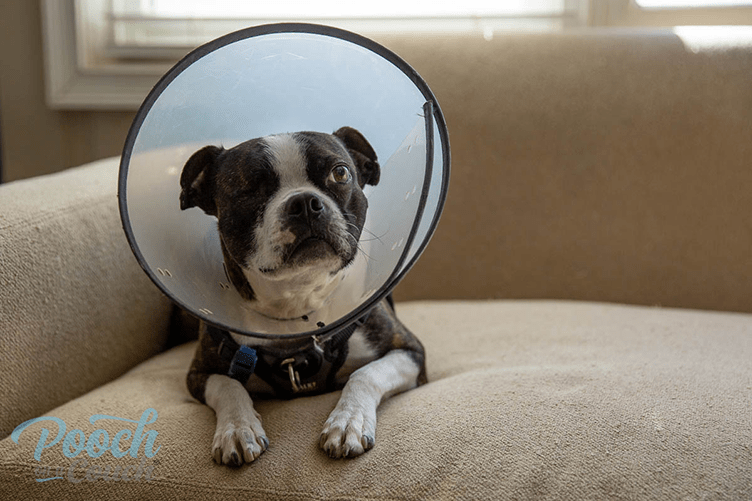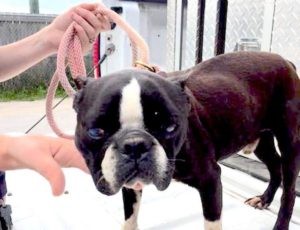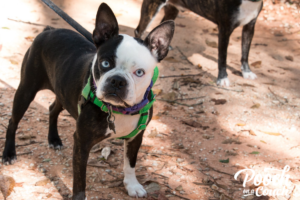The Elizabethan collar or the e-collar. Affectionately also called the cone of shame. Conehead. Lampshade. Satellite dish. Martini glass. Party hat.
We hate the cone of shame because we think our dog hates the cone of shame. They hate the cone of shame because we act like we hate the cone of shame. Maybe the dog wants us to think they hate the cone of shame so we will hate the cone of shame and take it off.
They absolutely want us to take it off.
When I say cone, I’m really talking about all of the about-the-head products available to protect our pets from licking themselves raw or chewing themselves open. These include:
- the veterinary issue plastic Elizabethan collar
- the soft cones
- inflatable donuts
Dogs don’t like any of them. Why? They are restrictive and they feel weird.
However….. our dogs need protection from themselves when recovering from a surgery or condition. Too often, we opt to take off the cone and never choose an alternate product. If you aren’t going to invest in another product, then you owe it to yourself, your dog and – if you are a dog foster home – you owe it to your rescue agency to USE THE CONE.
Tender Hearts
I get it. You are tender-hearted. So am I. I pick up a lot of foster dogs post spay/neuter from the vet. The tech and dog round the corner into the lobby of the vet clinic and there it is:
The most pitiful face ever – surrounded by a plastic cone. The head hangs low, dragging the edge of the e-collar on the floor. Peripheral vision restricted, they bump into a chair. The dog looks up at you with the most pleading, sad eyes: “Why, Mom. Dad. WHY”?
Resistance To The Cone of Shame Runs Deep
The vet tech or veterinary nurse looks you dead in the eye and says, “He must wear this cone all the time until the recheck in 10 days”.
And you immediately think, “Yeah, right”. You intend to take this awful, cruel contraption off of your dog as soon as you get home. Maybe as soon as you get to the car.
Your dog would never bother the part of the body needing protection. This dog is too smart and knows you’ve worked hard to provide them this good care.
And your observation skills are stealth.
Yes, even at 2 a.m. when you are fast asleep, your perfect dog isn’t bothering the sutures. Or eating the bandage. Licking the incision. Rubbing the eye. Not your awesome dog.
Until they do.
It only takes a few seconds of chewing for a dog to undo its stitches or damage the surgery site.
John DoeCheryl Yuill, DVM, MSc, CVH
Who Hates The Cone?
Are you sure your dog already hates the cone or have you already made the decision to not even try to help your dog work through the unfamiliarity of wearing one?
Who hates the cone? YOU DO.
The Consequence of Resistance
Failure to comply with veterinary instructions regarding the use of the cone results in extra veterinary expense, interruption in recovery, and extra stress and pain for your dog.
It hurts your pocketbook. If you are fostering for a rescue agency, it most certainly hurts their operating expenses.
Truth Bomb: Donors want their dollars to go toward restoring health to neglected dogs and for spay/neuter, not uh-oh expenses caused by avoidable injury due to non-compliance.
I’m not going to fill up this post providing you with links and links to horror stories. But I will say this: dogs (and cats) have mortally injured themselves by chewing open their sutures after a spay/neuter surgery or became handicapped after destroying a several-thousand-dollar orthopedic surgery. You definitely don’t want to arrive home or awaken to that tragedy.
A Few Myth Busters
- A dog’s saliva has healing properties.
FACT: The tongue, especially in cats, is so rough that it can destroy healing tissue and therefore delay healing. Also, a dog’s mouth is full of bacteria. - You’ll know it if your dog starts to bother the incision site.
FACT: Pets have an amazing inherited skill, which allows them to chew up twenty stitches or staples in less than two seconds flat. - Your dog knows your intention when you take the cone on and off.
FACT: If you put the cone back on only when you are doing less desirable things such as putting the dog in a crate or leaving the house, your pet may take it as a punishment and may try to destroy it. They don’t reason that you are putting the cone on because you cannot supervise.
It is quite confusing to your dog when you take the cone on and off.
Wearing The Cone Of Shame
I remember the very first time I put the cone on my little Boston terrier, Indy, right after her spay surgery. She was still a puppy. Velcro secure, I took both hands off of the cone and thunk! Indy’s head, cone and all, dropped to the floor, and she stood there, chin glued down as if the cone was so heavy she couldn’t possibly lift her head off of the floor. Pitiful! I felt so bad!
I persevered, reassured her, made the navigation process easy – and in less than two days my little pitiful puppy was moving around with the cone on like a boss. She even learned how to navigate out the pet door with her lampshade on!
Emmy Lou, a foster dog, quickly let me know her feelings about the Comfy Cone – she’s deaf and needed her eyes. We tried the inflatable donut: she hooked her paw behind it and flung it off of her head, the donut sailing across the room. Message received, little one!
I switched her to a different product – the plastic Elizabethan collar- and she was more settled.
Our dogs are more adaptable than we are. We humans really hate change. Dogs quickly learn how to live in spite of it.
It’s our response and attitude that makes the biggest impact on our dog’s response to the cone.
Leaving the Elizabethan collar on at all times is the best way to get your pet used to it.
Dr. Phil Zeltzman, DVM, DACVS, CVJ
The Cone Of Shame – Teach Your Dog, Teach Yourself
Teach your dog to love the cone. Even when they are already wearing it! If you have time to train your dog to the cone in anticipation of a surgery or procedure, that is a golden opportunity, but it is not a missed opportunity, either.
Most of my foster dogs have never before worn the cone and I usually haven’t seen them until they are already spayed or neutered. So, I don’t have time to prepare them for the cone.
Next (pretend if you need to), that your dog has a brand new mobility challenge requiring modifications.
In order to help your dog navigate the home while wearing a cone, you will need to adapt your caregiving routine.
Check Your Emotions At The Door
Your response to your puppy dog’s sad eyes is valid. It’s ok to have that “poor dog!” moment. You can feel bad about the situ. Compassion is an important part of who you are.
But, your feelings don’t help you help your dog. So, check your emotions and get busy making your dog’s journey with the cone the best experience you can make it for your dog.
Pretend, If You Have To
Pretend your dog has a brand new mobility challenge that requires you to modify your home, your routine, and how you help your dog.
Game 1: Aim For The Bowl
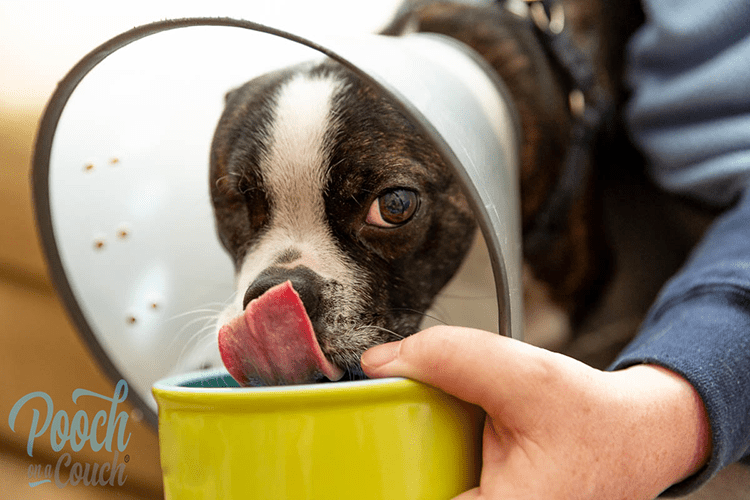
Dogs Learn Fast When They Are Having Fun
Games are fun. Treats are fun.
So, to get a dog used to aiming their head+cone for the bowl, I play a game.
First, I may hold the bowl elevated off of the floor at nose level, and ask them to approach and get the treat out of the bowl.
When we achieve success, I lower the bowl further and further toward the floor. My goal is to get them used to the sensation of the edge of the cone touching another object and moving/making sounds.
If the dog is having fun, the less likely they are going to become upset if they bang the cone on the edge of the bowl or floor. If my dog does this and then backs up or seems unsure, I simply reply, “Whoops” and repeat the exercise.
Lots of praise in an excited voice rewards the dog for their successes.
I also modify the height of the food/water bowl like this:
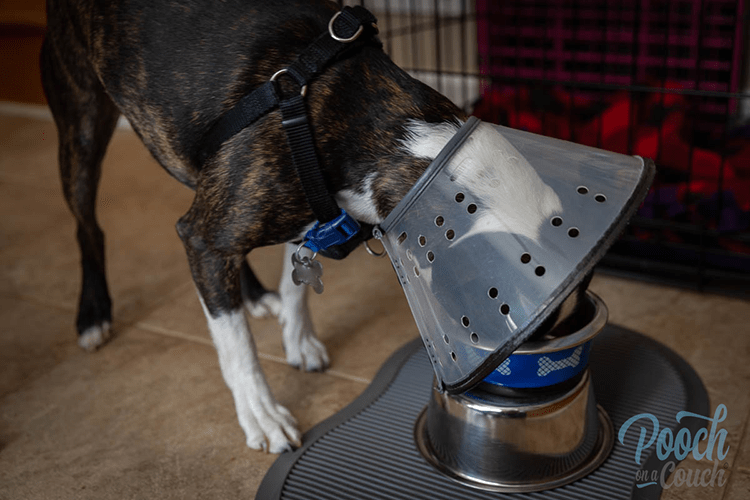
I’ve looked for a satisfactory elevated narrow bowl and I have not found one that seems to match what I’m looking for. If you have one – please share where you found it!
Game 2: Walk like …. Queen Elizabeth!
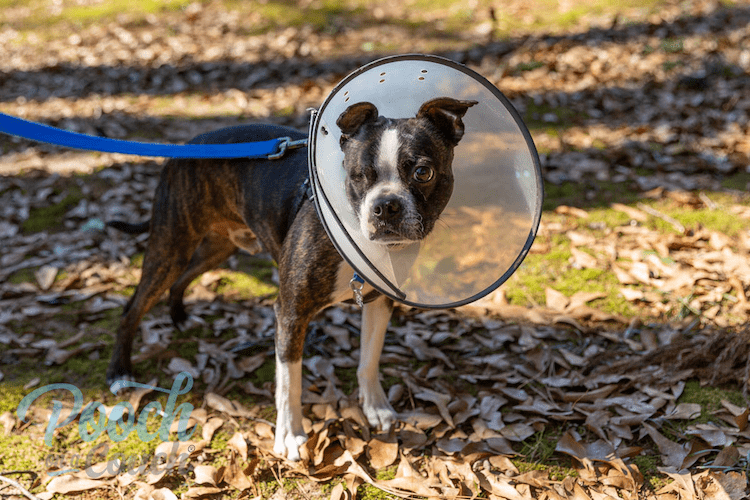
Use a 4′ leash when walking your dog outdoors when they are first learning to wear the e-collar.
Your dog is likely hanging their head low, causing the cone’s edge to drag the ground and catch on objects. This pulling and tugging and jarring is unfamiliar, confusing, and upsetting to your dog.
Encourage them to hold their head up.
- Start with REALLY short walks.
- Fill your pockets full of treats.
- Reward the dog every time he/she looks up at you.
- If the dog gets the cone stuck, just stop and wait for them to figure it out. You might encourage them to look up at you, or encourage them to take a step backward. Give them just a minute to problem solve, but intervene if they act frustrated.
For other tips on helping your dog adjust to wearing the cone of shame, check out:
The Elizabethan Collar: 9 Easy Ways To Help Your Dog Adjust To Wearing One.
5 Alternatives To The Cone
Disclaimer: this post contains affiliate links. I earn a small commission on qualifying purchases at no cost to you.
Always check with your veterinarian to see if your product choice is safe. Any of the products below may be contraindicated for a particular procedure your dog is having. For example, dogs with delicate eye issues such as corneal grafts shouldn’t use donuts, stiff collars, or soft cones. The stiffer plastic “vet issue” cone offers the best protection to the eye as it heals. Dogs will use the textured inside of the Comfy Cone to rub their eye when it hurts or itches.
Comfy Cone – a popular alternative to the plastic cone. NOT good for dogs who’ve had eye surgeries – they can easily scratch the eyeball and pull loose those tiny, delicate sutures. I also find that this design impairs vision worse than the opaque “vet issue” cone. Dogs appreciate their peripheral vision. It does seem to be more comfortable for dogs when they are resting in their crates.
Inflatable Donut – This has limited use, in my opinion. Some breeds who have small heads are most definitely going to be able to get this product off quite quickly, and you don’t want to put this product on too tightly. You can cause airway problems. I use this as an alternative to the cone ONLY when I’m present to supervise. For example, during sofa time in the evenings.
Bite Not Collar – The manufacturer states this collar is not good for keeping eyes or ears safe, however, this design may be an alternative for dogs that are super resistive to the cone. Use with supervision; some dogs are going to be able to get to lower parts of their body. The Bite Not Collar, improperly supervised, can trap moisture, rub raw places on their pet’s neck, cause irritation, skin breakdown, and open wounds. I think it looks quite uncomfortable, and it wouldn’t be my first choice for e-collar alternatives.
Onesies/T-shirts – again – I use these with caution, but a lot of my rescue friends use these when protecting spay surgical sites. I think they are fine to inhibit a dog licking sutures or hot spots or skin inflammations. Despite their popularity, I see a determined dog chewing through these or being able to tug at sutures or staples through the fabric. USE WITH CAUTION, and use under supervision.
I’ve used the Comfy Cone, the inflatable donut, and t-shirts/onesies and I have all in several sizes in my fostering equipment box. My favorite is still the plastic Elizabethan collar. I find my dogs are safer as well as more comfortable with a correctly fitted vet-issue type plastic Elizabethan collar when I help them overcome the unfamiliarity of wearing one. I do have my favorites in which fasteners are used – like the snap closure Elizabethan collar, however I appreciate the ones that are more difficult to take off/put on as I find them to be a deterrent to human tampering, if you get my drift.
The Comfy Cone is something I use when appropriate and when my foster dog is OK with the visual limitations the Comfy Cone brings.
Addendum: I’ve discovered a new Elizabethan collar product that seems to combine the soft, comfy cone with the opaque plastic “vet-issue” cone. I have not tried this on my dogs, but it looks interesting.
Bottom line – don’t be afraid to use the cone of shame on your dog. Your dog really will adjust to it with a little bit of help. Do you have a favorite e-collar product? Tell me about it!
